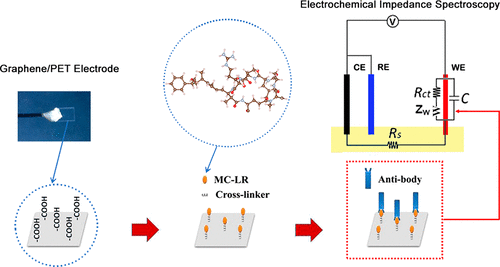Our official English website, www.x-mol.net, welcomes your
feedback! (Note: you will need to create a separate account there.)
Electrochemical Biosensing of Algal Toxins in Water: The Current State-of-the-Art
ACS Sensors ( IF 8.2 ) Pub Date : 2018-07-05 00:00:00 , DOI: 10.1021/acssensors.8b00359 Wei Zhang 1, 2, 3 , Mike B. Dixon 4 , Christopher Saint 2 , Kar Seng Teng 3 , Hiroaki Furumai 1
ACS Sensors ( IF 8.2 ) Pub Date : 2018-07-05 00:00:00 , DOI: 10.1021/acssensors.8b00359 Wei Zhang 1, 2, 3 , Mike B. Dixon 4 , Christopher Saint 2 , Kar Seng Teng 3 , Hiroaki Furumai 1
Affiliation

|
Due to increasing stringency of water legislation and extreme consequences that failure to detect some contaminants in water can involve, there has been a strong interest in developing electrochemical biosensors for algal toxin detection during the past decade, evidenced by literature increasing from 2 journal papers pre-2009 to 24 between 2009 and 2018. In this context, this review has summarized recent progress of successful algal toxin detection in water using electrochemical biosensing techniques. Satisfactory detection recoveries using real environmental water samples and good sensor repeatability and reproducibility have been achieved, along with some excellent limit-of-detection (LOD) reported. Recent electrochemical biosensor literature in algal toxin detection is compared and discussed to cover three major design components: (1) biorecognition elements, (2) electrochemical read-out techniques, and (3) sensor electrodes and signal amplification strategy. The recent development of electrochemical biosensors has provided one more step further toward quick in situ detection of algal toxins in the contamination point of the water source. In the end, we have also critically reviewed the current challenges and research opportunities regarding electrochemical biosensors for algal toxin detection that need to be addressed before they attain commercial viability.
中文翻译:

水中藻毒素的电化学生物传感:最新技术
由于水法规越来越严格,以及无法检测到水中某些污染物的极端后果,在过去的十年中,人们对开发用于藻类毒素检测的电化学生物传感器产生了浓厚的兴趣,文献从前两篇论文中得到了证明。 2009年至2009年的24至2009年之间。在此背景下,本综述总结了使用电化学生物传感技术成功检测水中藻类毒素的最新进展。使用真实的环境水样可实现令人满意的检测回收率,并具有良好的传感器可重复性和可重复性,并且报告了一些出色的检测限(LOD)。对藻毒素检测中的最新电化学生物传感器文献进行了比较和讨论,涵盖了三个主要设计组件:(1)生物识别元件,(2)电化学读出技术,(3)传感器电极和信号放大策略。电化学生物传感器的最新发展为向水源污染点中的藻毒素快速原位检测迈出了又一步。最后,我们还严格审查了有关用于藻类毒素检测的电化学生物传感器的当前挑战和研究机会,在实现商业可行性之前需要解决这些挑战和研究机会。
更新日期:2018-07-05
中文翻译:

水中藻毒素的电化学生物传感:最新技术
由于水法规越来越严格,以及无法检测到水中某些污染物的极端后果,在过去的十年中,人们对开发用于藻类毒素检测的电化学生物传感器产生了浓厚的兴趣,文献从前两篇论文中得到了证明。 2009年至2009年的24至2009年之间。在此背景下,本综述总结了使用电化学生物传感技术成功检测水中藻类毒素的最新进展。使用真实的环境水样可实现令人满意的检测回收率,并具有良好的传感器可重复性和可重复性,并且报告了一些出色的检测限(LOD)。对藻毒素检测中的最新电化学生物传感器文献进行了比较和讨论,涵盖了三个主要设计组件:(1)生物识别元件,(2)电化学读出技术,(3)传感器电极和信号放大策略。电化学生物传感器的最新发展为向水源污染点中的藻毒素快速原位检测迈出了又一步。最后,我们还严格审查了有关用于藻类毒素检测的电化学生物传感器的当前挑战和研究机会,在实现商业可行性之前需要解决这些挑战和研究机会。

















































 京公网安备 11010802027423号
京公网安备 11010802027423号